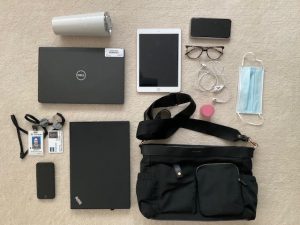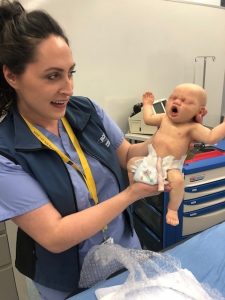

Hello everyone,
My name is Jessica Presta and I have included two pictures to help you get to know me. The first picture is of the contents of my work bag. The second picture is of me in the SIM lab at British Columbia Institute of Technology (BCIT)! Not to worry, that is not a real newborn!
The items in my work bag include:
- Thinkpad laptop – corporate (BCIT)
- Dell laptop – corporate (Fraser Health Authority, FHA)
- Smart phone – personal
- Smart phone – corporate (FHA)
- iPad – corporate (BCIT)
- Surgical mask
- BCIT ID
- Fraser Health ID
- Headphones
- Lineige lip mask
- Glasses
- Coffee mug
- Car keys in the pocket
As you can see, the contents of my bag speak loudly to my current working situation. I will elaborate. I am a critical care nurse by trade and I have worked in the Intensive Care Unit (ICU) for 10 years. After a decade at the bedside I decided to pursue a career in education, working as faculty in the Critical Care Nursing Program at BCIT. I started this role back in 2019 and fell in love with education which was what motivated me to take the MET. This program has been wonderful and I am grateful for the people I am meeting and the learning it affords me. In February of this year, an opportunity to develop Fraser Health’s electronic healthcare records arose (moving us away from a paper based system of ‘text’ to a digital one), so I applied and was hired onto the team. I work closely with subject matter experts as a clinical practice consultant developing and building the system for use by providers and other healthcare workers. My role with FHA is full time and I am continuing to work for BCIT in a part-time capacity, overseeing the delivery of our program on Vancouver Island. I mostly work from home, however if I need to be onsite for whatever reason, I am required to bring these digital text items with me so that I can conveniently and efficiently access BCIT or FHA related information, emails, etc. Additionally, all of these devices double as materials I use for completing course work for my MET. This term I also decided to take on two courses! So your well wishes are much appreciated.
The other items are more self explanatory. Coffee is an absolute must, every day. It is what keeps me going. I also cannot leave home without my lip gloss! The surgical mask is required when doing hospital/site visits, along with my ID’s. These give me access to various facilities. Last are my headphones. These can be used if I have to be in a virtual meeting when I am in an office/public space, or when listening to music while studying/working. Music is another form of text that I enjoy.
It is fascinating to think about these items in the context of ‘text technologies’ and how they enable me to engage with language while providing a portable means of communication. I think the concept of portability is what strikes me the most. There is this notion of immediacy, an expectation of being able to reach me anytime throughout the day. A feeling of always being plugged in because I always have these devices in arms reach, no matter where I go. It has led to increasing amounts of multitasking, emailing, and virtual meetings. Some days it feels like I need to be available in person and virtually at the same time.
The other connection I made was to the amount of technology I carry around, the resources required to create these devices, and how five to ten years ago, my bag would have been full of papers. When I first started transitioning away from paper based text to digital forms of text, I felt proud of myself for being more conscientious of the trees. Now, I realize that the data being stored on my various devices requires incredible amounts of energy and however many servers in order for me to have digital copies. I would argue that the latter may be worse.

Jessica, it was so interesting to learn more about you! Something that resonated with me was when you mentioned that 10 years ago you would have had papers in your purse, and now there are no papers to be found. At the beginning of my teaching career, I had to manage and organize an exceptional amount of documents, while teaching 8th grade. Now, using Google Classroom, most student work is stored on that platform and is organized and accessible. It makes me curious about the changes ten years from now!
Hi Agnes!
Thank you so much for your contribution to my post and for sharing your own work experience. My sister in law teaches grades 6 and 7 and she was walking me through her Google classroom. I cannot believe how technology has evolved the learning and writing spaces of k-12 from when we were students! I am going to pop over to your page now and read your post! See you there 🙂